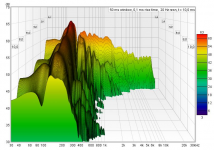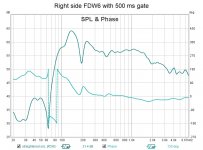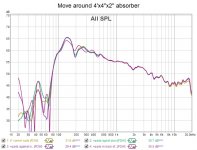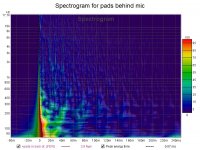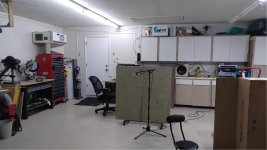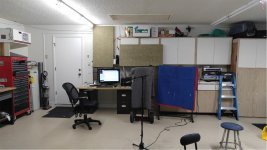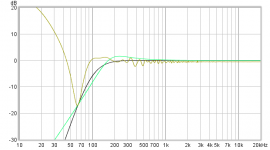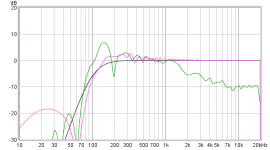You could try looking at an ETC banded in octaves or less to see if that shows anything different.
Thanks. I was looking but not seeing.
That hole is the null and it has to be at just over 5 ms, half the period of the null at just under 200 Hz. It can't be anywhere else for that null.
But the 200 hz energy is spread out in time. Else there wouldn't be any around after the null passes by. But the intensity is normalize; perhaps that is misleading us.
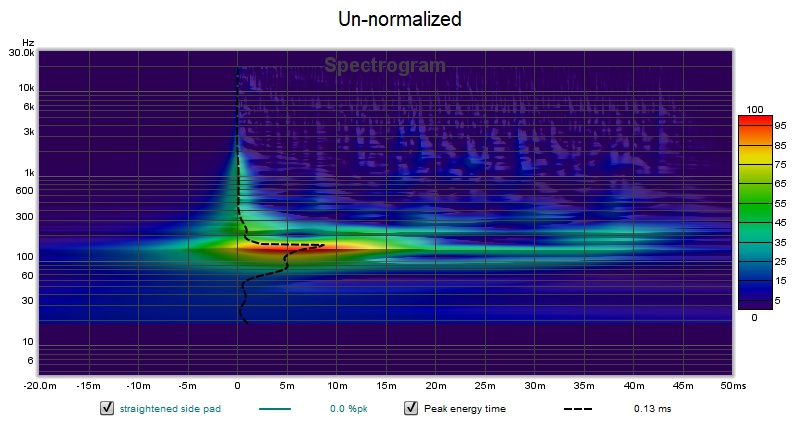
It seems to cancel right from the start at 200 Hz. In other words a deep null from the first cycle on. A 1.7 m path length difference out to the microphone.
Anything visible in the filtered IR tab at ~5 ms? Or as Fluid suggests, filtering it at the 200 Hz frequency (in that same tab) for another look at it. Flip back to the IR tab after filtering to see the wave shape.
Up to what frequency does the subwoofer have clean output? 🙂 Maybe they can share this load at 200 Hz.
Nice progress for sure !!
Have you tried moving the sub relative to the array(s)? To see if the notch moves with that?
Or better yet, but very difficult to do for a sub indoors, can you get independent phase traces of the sub and arrays, to check phase/time alignment?
My experience is, if a sub isn't closely co-located with the 'main', it can be hard to differentiate between floor bounce changes down low, and phase-to-mic triangulation differences between sub and main, as the mic is moved around....
Just spitballing some 🙂
Have you tried moving the sub relative to the array(s)? To see if the notch moves with that?
Or better yet, but very difficult to do for a sub indoors, can you get independent phase traces of the sub and arrays, to check phase/time alignment?
My experience is, if a sub isn't closely co-located with the 'main', it can be hard to differentiate between floor bounce changes down low, and phase-to-mic triangulation differences between sub and main, as the mic is moved around....
Just spitballing some 🙂
Sitting here watching first mountain stage of this year's Tour De France, itching to get back at the speaker project. But I love mountain stages...
I haven't activated the woofer yet on this side as I did on the other. I meant to but got distracted trying to find the source of this reflection. Overlapping the woofer will help but as you suggest I can't overlap it too high unless I bring the array closer into the corner with the woofer. But I just need to inject some in phase energy into the bottom of the null so one way or another I can make it work.
Meanwhile I see my box of Roxul is out for delivery.
I haven't activated the woofer yet on this side as I did on the other. I meant to but got distracted trying to find the source of this reflection. Overlapping the woofer will help but as you suggest I can't overlap it too high unless I bring the array closer into the corner with the woofer. But I just need to inject some in phase energy into the bottom of the null so one way or another I can make it work.
Meanwhile I see my box of Roxul is out for delivery.
Attachments
Wouldn't the distance difference be 0.85m?It seems to cancel right from the start at 200 Hz. In other words a deep null from the first cycle on. A 1.7 m path length difference out to the microphone.
Yup, you're right. Half the wave length of 200 Hz as it cancels the build up of energy at that frequency.
How much room is there between array top and ceiling?
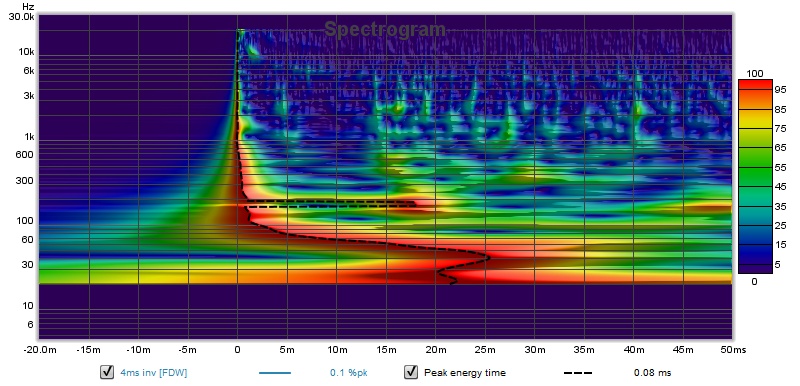
The left side seems to have something similar going on (delay around the 200 Hz point) but not as deep a null.
(but we are looking at a normalized graph)
This side is with a sub running, right?
The left side seems to have something similar going on (delay around the 200 Hz point) but not as deep a null.
(but we are looking at a normalized graph)
This side is with a sub running, right?
Last edited:
I've got 17" down from the ceiling to the top of the top driver; ceiling height is about 100".
The only other things within reach of causing that reflection is the track for the overhead door and the wooden frames of the absorbers both of which are shielded by the absorbers.
And yes, the same similar thing is going on on the other side. I get 6 db deep dips with the gate open wide enough for these reflections. Curious, that we calculate 5ms path length difference but setting a gate at 12 ms kills the reflection. What is there to bounce off at 15ms path length? Now we are back considering side and front wall
The only other things within reach of causing that reflection is the track for the overhead door and the wooden frames of the absorbers both of which are shielded by the absorbers.
And yes, the same similar thing is going on on the other side. I get 6 db deep dips with the gate open wide enough for these reflections. Curious, that we calculate 5ms path length difference but setting a gate at 12 ms kills the reflection. What is there to bounce off at 15ms path length? Now we are back considering side and front wall
How about no gate and a FDW of 6 cycles? One cycle at 200 Hz is 5 ms. So we only "see" 2 cycles.
AHA!
Today I built a new 4" thick pad short enough to fit under the garage door when its open. I had two 2" pads left over so moved them around to see where they did the most good.
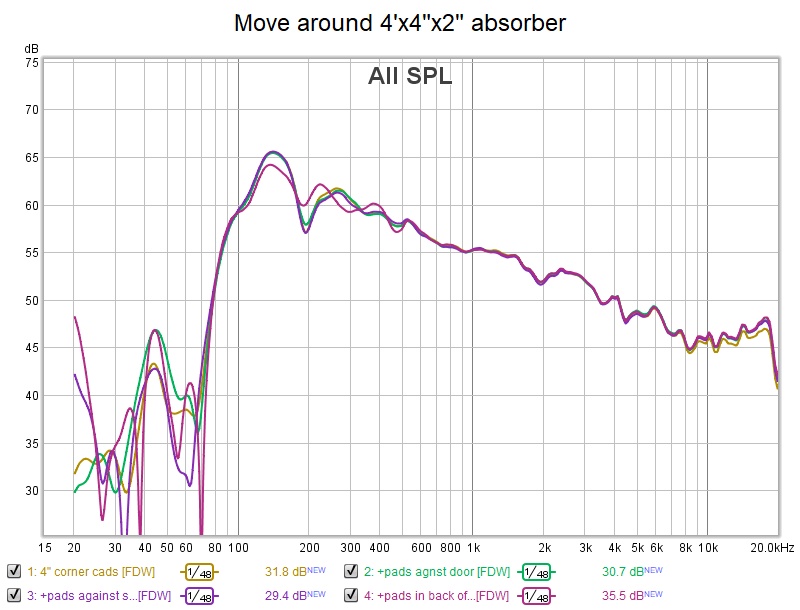
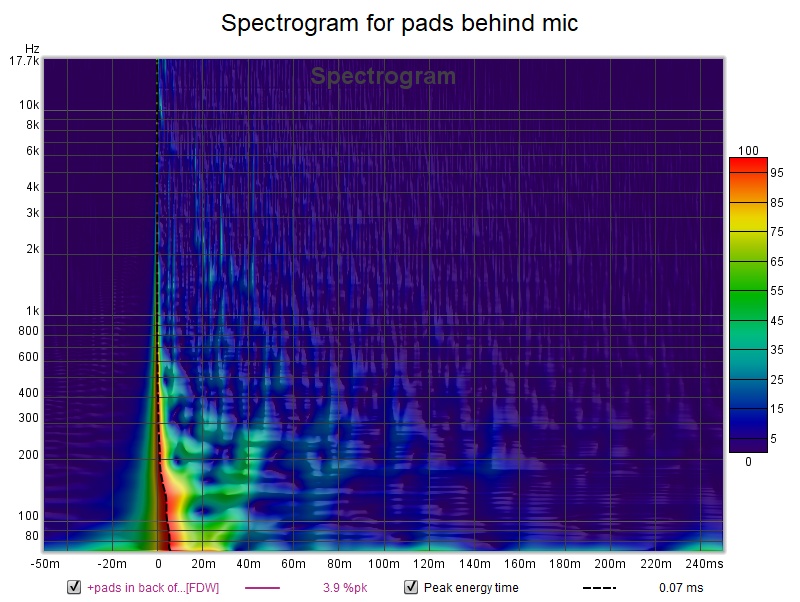
I scrolled the low bass off the screen as the woofer was off. the normalized display there was really ugly...
Placing 16 sq ft of 2" thick pad against garage door reduced depth of null by 1 db or so. Placing those pads instead behind the mic made a huge difference so now I have to pad that back wall.
Today I built a new 4" thick pad short enough to fit under the garage door when its open. I had two 2" pads left over so moved them around to see where they did the most good.
I scrolled the low bass off the screen as the woofer was off. the normalized display there was really ugly...
Placing 16 sq ft of 2" thick pad against garage door reduced depth of null by 1 db or so. Placing those pads instead behind the mic made a huge difference so now I have to pad that back wall.
Attachments
Here is the pad configuration that "worked"
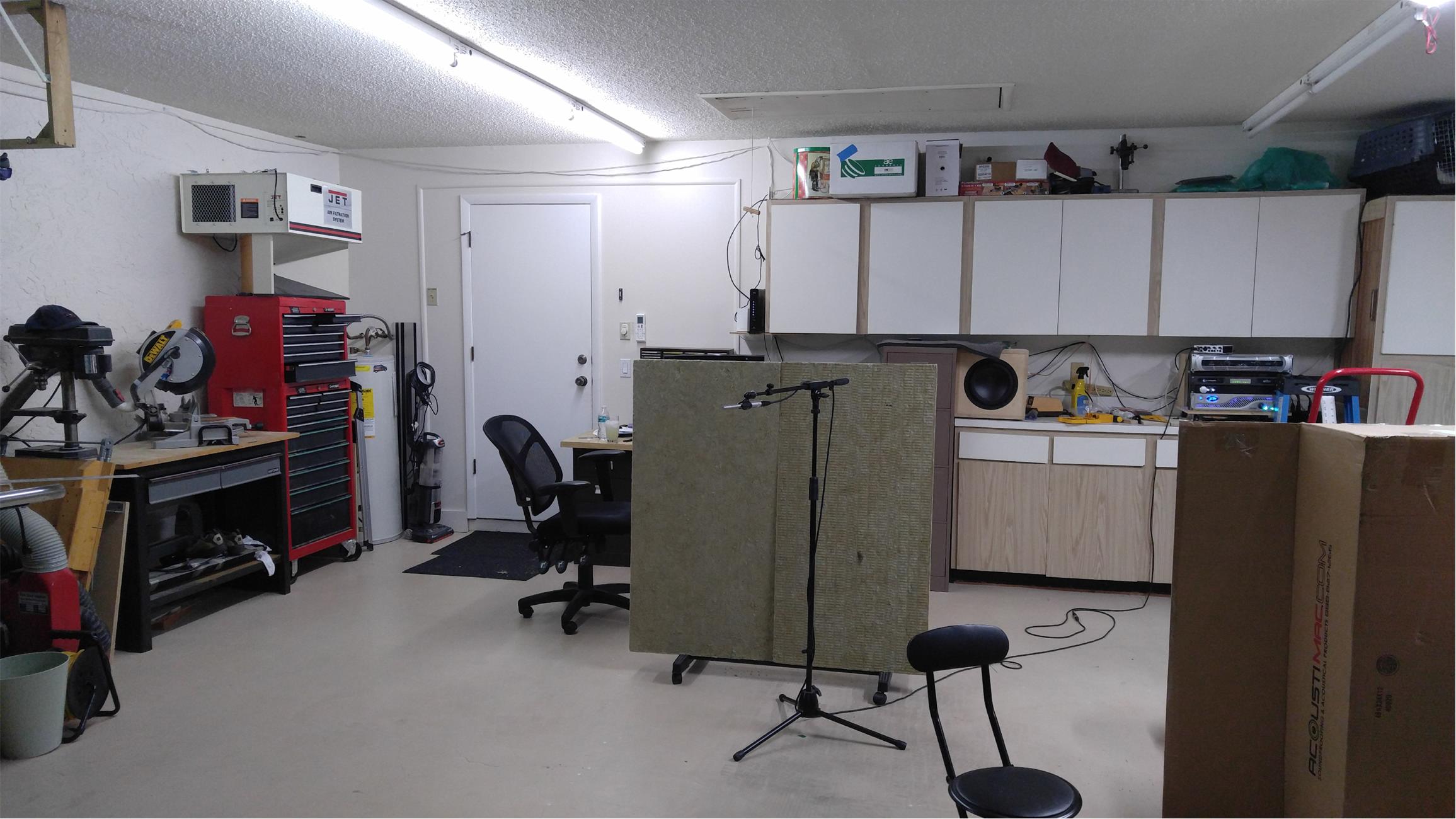
Putting those same pads up on the wall is far from sufficient. I would need 2-4x the area and they might have to be 4" thick. But that would be the right way to do it.
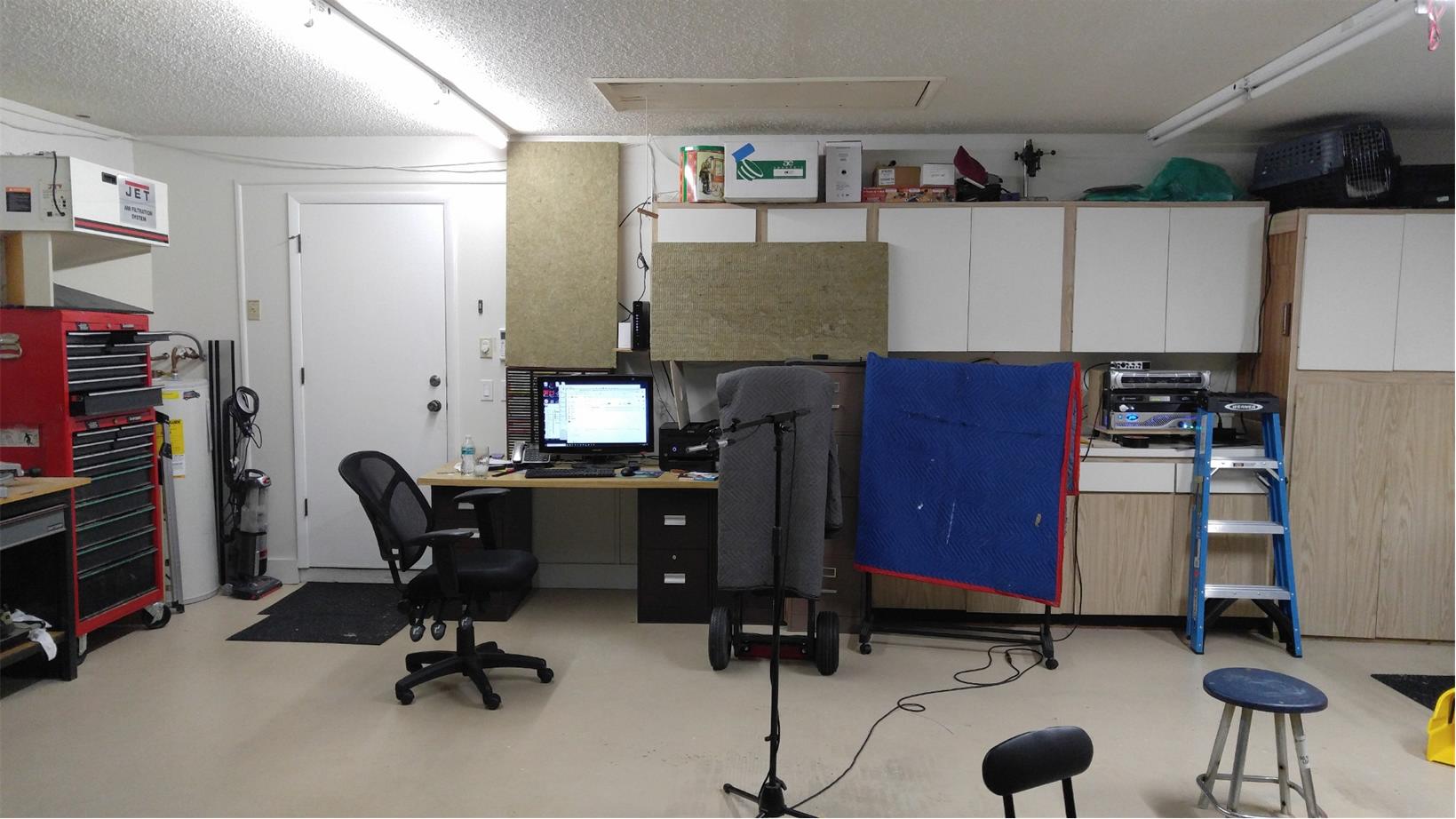
at these frequencies, those moving blankets don't do anything.
The practical thing for me to do for now is to dress up those two pads and put them on a roller stand.
Putting those same pads up on the wall is far from sufficient. I would need 2-4x the area and they might have to be 4" thick. But that would be the right way to do it.
at these frequencies, those moving blankets don't do anything.
The practical thing for me to do for now is to dress up those two pads and put them on a roller stand.
Attachments
Black curve is target HP filter 4th order LR at 100Hz, green curve is a Q about 1,05 at 174,5Hz number from impedance plot at post 258, gold curve is rough estimated distance numbers taken from your room pictures filled into Jeff Bagby spreadsheet for one driver.
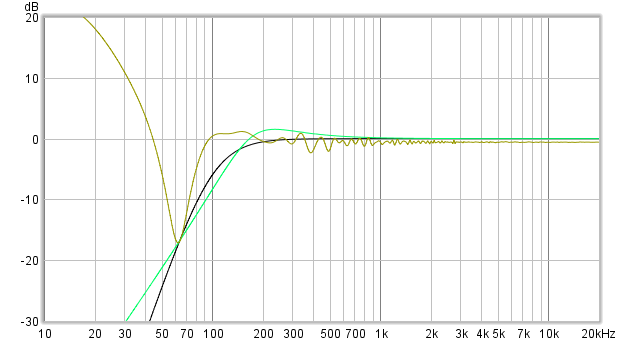
Above green curve times gold curve predict below purple curve for one SB65 driver at 50 inch hight in room and green curve below is real array from post 274 right side sans shelf filter response, looks right that above about 1225Hz point spacing ruin summing for a declining curve and below that 1225Hz point 1/4 wave rule for spacing distance draw a climbing curve, spreadsheet predict the about 62Hz null that ruin target curve will go away if array is placed closer or tightly into a real corner well actual response will be very different compared to using about a 5 feet distance to rear and side wall as in below graph, 197hz null is the problem so far.
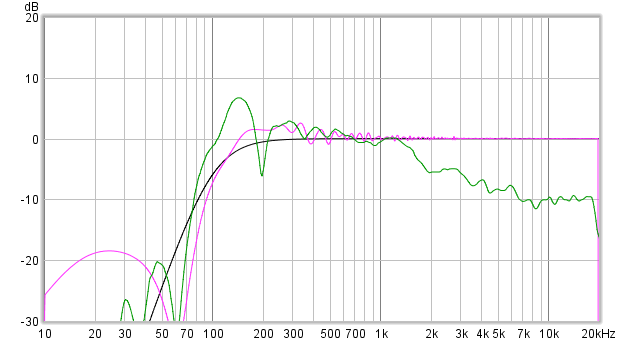
Above green curve times gold curve predict below purple curve for one SB65 driver at 50 inch hight in room and green curve below is real array from post 274 right side sans shelf filter response, looks right that above about 1225Hz point spacing ruin summing for a declining curve and below that 1225Hz point 1/4 wave rule for spacing distance draw a climbing curve, spreadsheet predict the about 62Hz null that ruin target curve will go away if array is placed closer or tightly into a real corner well actual response will be very different compared to using about a 5 feet distance to rear and side wall as in below graph, 197hz null is the problem so far.
Attachments
Hi BYRTT:
We don't have to use JeffB's spreadsheet anymore, Vituix now does room response. Should I post my Vituix model? I know you are a Vituix fan. Funny, I haven't touched it since I had something to measure and I never modeled the boundary distances its experiencing now, just distances of a few inches.
I designed this array to fit tight into a corner absorber itself fit tightly into a corner. or up against a planar absorber itself tight to a wall. Done right, 1" (worst case 2") absorbers suffice. The further out from the corner it sits, the thicker the absorber needed to prevent boundary nulls. Now I find myself using the out in the room, as it has to be because of all the stuff it has to coexist with, but apparently far enough out that the front and side wall nulls are out of band. Its the back wall reflection causing the problems here as I attempted to show in my last two posts.
I'm impressed again by your re-engineering based on my posts. I don't care about a 60 Hz null since its out of band; subs do that range. As to placing the array more tightly into a corner, that was my original design premise. Unfortunately, no free, unobstructed corners or wall space are available in this space. Maybe my wife will let these speakers come in from the cold (well, heat here in Florida) some day 🙂
Jack
We don't have to use JeffB's spreadsheet anymore, Vituix now does room response. Should I post my Vituix model? I know you are a Vituix fan. Funny, I haven't touched it since I had something to measure and I never modeled the boundary distances its experiencing now, just distances of a few inches.
I designed this array to fit tight into a corner absorber itself fit tightly into a corner. or up against a planar absorber itself tight to a wall. Done right, 1" (worst case 2") absorbers suffice. The further out from the corner it sits, the thicker the absorber needed to prevent boundary nulls. Now I find myself using the out in the room, as it has to be because of all the stuff it has to coexist with, but apparently far enough out that the front and side wall nulls are out of band. Its the back wall reflection causing the problems here as I attempted to show in my last two posts.
I'm impressed again by your re-engineering based on my posts. I don't care about a 60 Hz null since its out of band; subs do that range. As to placing the array more tightly into a corner, that was my original design premise. Unfortunately, no free, unobstructed corners or wall space are available in this space. Maybe my wife will let these speakers come in from the cold (well, heat here in Florida) some day 🙂
Jack
Thanks Jack remind me VituixCad have had room feature build in, i need to look it up and educate : ) your design and planning looks great and based on what i heard twice at wesayso's livingroom i'm pretty shure further down the road when your wife have let these wonders into living room and you finished your wise educating research that you get over avarage fanstatic system performance : ) that said my own experience is when your sound get to those quality levels you will subjective notice that 62Hz null over time and not call it out of band, but problem should pretty much fix itself when arrays get fit tight or closer into a corner or linear phase summing to sub could also fix it if global system sound is allowed some lag from DSP engine.
Ricky
Ricky
- Home
- Loudspeakers
- Full Range
- Full range line array for wall or corner placement

